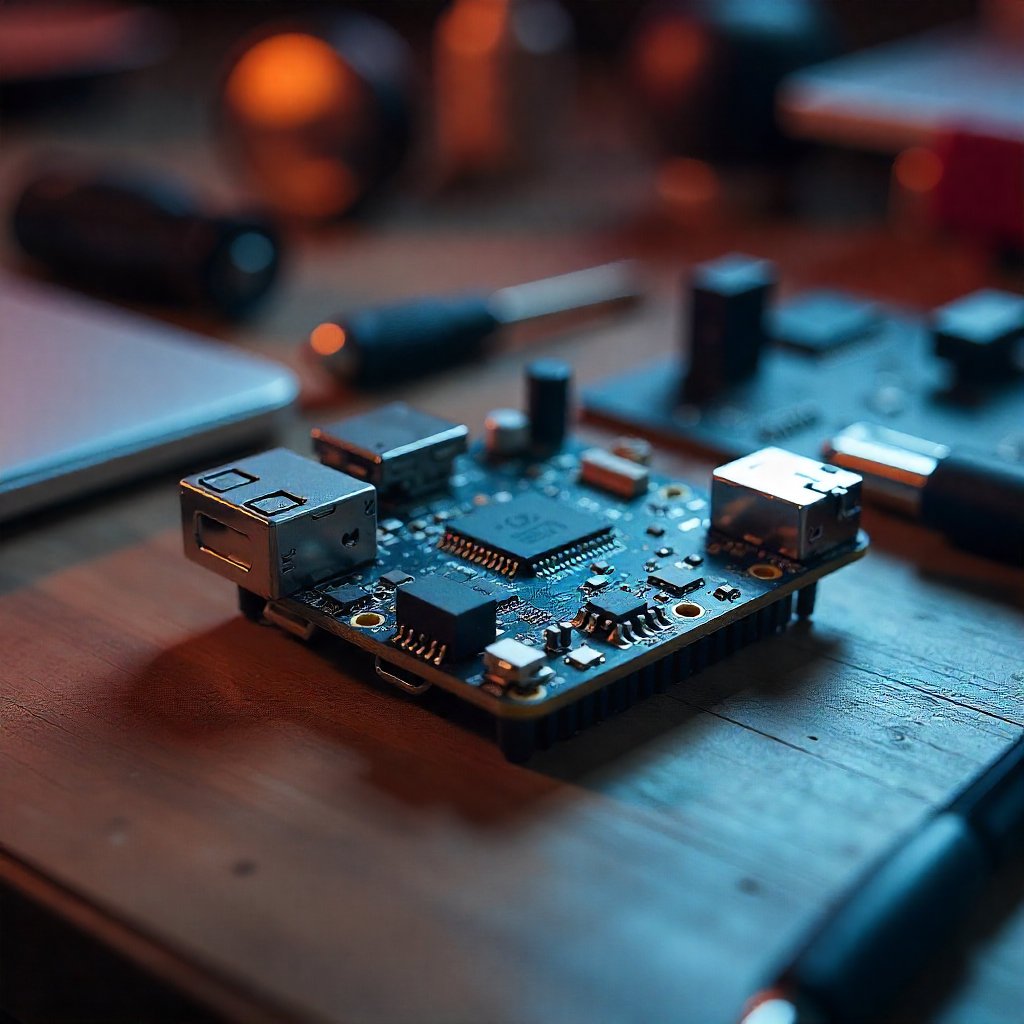Edge AI is transforming how devices think — no cloud, no delay, just on-board intelligence.
The ESP32-CAM merges Wi-Fi, camera, and compute power in a few dollars of silicon, while TinyML enables deep-learning inference directly on the microcontroller.
🤖 Why TinyML on ESP32 Matters
TinyML lets microcontrollers run machine-learning models that once needed servers.
With ESP32-CAM, you can deploy models that see, hear, and act instantly, without sending data off-device.
Key Advantages
- Low Latency: Inference happens locally in milliseconds.
- Data Privacy: Images or signals never leave the device.
- Network Independence: Works even with intermittent connectivity.
- Cost Efficiency: less than USD 10 hardware and minimal cloud usage.
- Scalability: Thousands of devices can process and act independently.
🏭 Industrial Use Cases
| Domain | Applications |
|---|---|
| Manufacturing | Defect detection, assembly verification, tool-wear analysis |
| Smart Buildings | Occupancy detection, lighting/HVAC automation |
| Retail | Shelf stock monitoring, queue length detection |
| Safety | PPE detection, restricted-area alerts |
| Utilities & Energy | Flame/smoke detection, gauge reading |
| Agritech | Pest spotting, crop-health monitoring |
Each use case benefits from running inference at the source, reducing bandwidth and increasing reliability.
⚙️ Edge AI Architecture
Sensor (Camera / ADC)
↓
Pre-Processing
↓
TinyML Model (TFLite Micro)
↓
Local Action (LED / Relay / MQTT)
↓
Optional Cloud DashboardThis architecture allows instant decision-making while keeping cloud components lightweight.
🧩 Hands-On: Person Detection Demo (ESP32-CAM)
A minimal TinyML person-detection project running locally on ESP32-CAM. This demo uses the TensorFlow Lite Micro person_detection model and toggles the onboard LED when a person is detected.
/*
* Project: ESP32-CAM TinyML Person Detection
* Description:
* Runs a TensorFlow Lite Micro model for person detection on the AI Thinker ESP32-CAM.
* Captures grayscale frames, resizes to 96×96, performs inference locally,
* and toggles the onboard flash LED when a person is detected.
*
* Hardware: AI Thinker ESP32-CAM (OV2640)
* Framework: Arduino (PlatformIO)
* Author: Sony Sunny
* Date: 2025-10-22
*/
#include <Arduino.h> // Core Arduino functions
#include "esp_camera.h" // ESP32-CAM camera driver
// === Pin definitions for the AI Thinker ESP32-CAM ===
// These map the ESP32 GPIOs to the camera’s physical pins.
#define PWDN_GPIO_NUM 32 // Power down pin (turns camera off/on)
#define RESET_GPIO_NUM -1 // Reset not used
#define XCLK_GPIO_NUM 0 // XCLK signal for camera clock
#define SIOD_GPIO_NUM 26 // I2C data line to SCCB (camera control bus)
#define SIOC_GPIO_NUM 27 // I2C clock line
#define Y9_GPIO_NUM 35 // Data pin 9
#define Y8_GPIO_NUM 34 // Data pin 8
#define Y7_GPIO_NUM 39 // Data pin 7
#define Y6_GPIO_NUM 36 // Data pin 6
#define Y5_GPIO_NUM 21 // Data pin 5
#define Y4_GPIO_NUM 19 // Data pin 4
#define Y3_GPIO_NUM 18 // Data pin 3
#define Y2_GPIO_NUM 5 // Data pin 2
#define VSYNC_GPIO_NUM 25 // Vertical sync signal
#define HREF_GPIO_NUM 23 // Horizontal reference signal
#define PCLK_GPIO_NUM 22 // Pixel clock signal
// === TensorFlow Lite Micro headers ===
#include "tensorflow/lite/micro/all_ops_resolver.h" // Registers all supported ops
#include "tensorflow/lite/micro/micro_interpreter.h" // Runs inference on microcontrollers
#include "tensorflow/lite/schema/schema_generated.h" // TFLite model schema
#include "tensorflow/lite/version.h" // Version check helper
#include "person_detect_model_data.h" // Compiled TinyML model (array of bytes)
// === Model input settings ===
static const int kNumCols = 96; // Model input width
static const int kNumRows = 96; // Model input height
static const int kNumChannels = 1; // Grayscale image = 1 channel
static const int kTensorArenaSize = 220 * 1024; // Working memory (RAM) for inference
static uint8_t tensor_arena[kTensorArenaSize]; // Memory buffer used by TFLM
// === TensorFlow model + interpreter pointers ===
const tflite::Model* model = nullptr;
tflite::MicroInterpreter* interpreter = nullptr;
TfLiteTensor* input = nullptr;
// Flash LED pin on AI Thinker board
const int FLASH_LED_PIN = 4;
// -----------------------------------------------------------------------------
// Function: resize_to_96x96_grayscale
// Downsamples a larger grayscale frame (160x120) to the 96x96 size
// expected by the TinyML model. Uses a simple nearest-neighbor method.
// -----------------------------------------------------------------------------
static bool resize_to_96x96_grayscale(uint8_t* dst, int dw, int dh,
const uint8_t* src, int sw, int sh) {
if (!dst || !src) return false; // Sanity check
int step_x = sw / dw; // Horizontal sampling step
int step_y = sh / dh; // Vertical sampling step
for (int y = 0; y < dh; y++) {
for (int x = 0; x < dw; x++) {
dst[y * dw + x] = src[(y * step_y) * sw + (x * step_x)];
}
}
return true;
}
// -----------------------------------------------------------------------------
// Function: init_camera
// Configures and initializes the ESP32-CAM peripheral.
// Returns true if camera setup succeeds.
// -----------------------------------------------------------------------------
static bool init_camera() {
camera_config_t config = {}; // Initialize configuration struct
config.ledc_channel = LEDC_CHANNEL_0; // LEDC timer channel for XCLK PWM
config.ledc_timer = LEDC_TIMER_0;
config.pin_d0 = Y2_GPIO_NUM;
config.pin_d1 = Y3_GPIO_NUM;
config.pin_d2 = Y4_GPIO_NUM;
config.pin_d3 = Y5_GPIO_NUM;
config.pin_d4 = Y6_GPIO_NUM;
config.pin_d5 = Y7_GPIO_NUM;
config.pin_d6 = Y8_GPIO_NUM;
config.pin_d7 = Y9_GPIO_NUM;
config.pin_xclk = XCLK_GPIO_NUM;
config.pin_pclk = PCLK_GPIO_NUM;
config.pin_vsync = VSYNC_GPIO_NUM;
config.pin_href = HREF_GPIO_NUM;
config.pin_sscb_sda = SIOD_GPIO_NUM;
config.pin_sscb_scl = SIOC_GPIO_NUM;
config.pin_pwdn = PWDN_GPIO_NUM;
config.pin_reset = RESET_GPIO_NUM;
config.xclk_freq_hz = 20000000; // 20 MHz camera clock
config.pixel_format = PIXFORMAT_GRAYSCALE; // Capture grayscale images
config.frame_size = FRAMESIZE_QQVGA; // 160×120 resolution
config.fb_count = 2; // Two frame buffers
// Initialize the camera driver
return (esp_camera_init(&config) == ESP_OK);
}
// -----------------------------------------------------------------------------
// setup()
// Runs once at startup.
// -----------------------------------------------------------------------------
void setup() {
Serial.begin(115200); // Start serial console
delay(300);
Serial.println("\n[ESP32-CAM] TinyML Person Detection");
// Prepare LED (used as output indicator)
pinMode(FLASH_LED_PIN, OUTPUT);
digitalWrite(FLASH_LED_PIN, LOW);
// Initialize camera
if (!init_camera()) {
Serial.println("Camera init failed");
while (true) delay(1000); // Halt here if setup fails
}
// Load the compiled TensorFlow Lite model from flash
model = tflite::GetModel(g_person_detect_model_data);
// Build interpreter — this binds the model, operations, and tensor arena
static tflite::AllOpsResolver resolver; // Includes all operators
static tflite::MicroInterpreter static_interpreter(
model, resolver, tensor_arena, kTensorArenaSize);
interpreter = &static_interpreter;
// Allocate input/output tensors inside the tensor arena
interpreter->AllocateTensors();
// Pointer to input tensor for convenience
input = interpreter->input(0);
}
// -----------------------------------------------------------------------------
// loop()
// Captures frames continuously, preprocesses them, runs inference,
// and lights the LED if a person is detected.
// -----------------------------------------------------------------------------
void loop() {
// Capture a frame from the camera
camera_fb_t* fb = esp_camera_fb_get();
if (!fb) return; // Skip if capture failed
// Resize the camera frame (160x120) to 96x96 for the model input
resize_to_96x96_grayscale(input->data.uint8, kNumCols, kNumRows,
fb->buf, fb->width, fb->height);
// Release the frame buffer so camera can capture next frame
esp_camera_fb_return(fb);
// Run inference using TensorFlow Lite Micro
if (interpreter->Invoke() == kTfLiteOk) {
// Fetch output tensor (contains model results)
TfLiteTensor* output = interpreter->output(0);
// Convert quantized int8 output to floating-point probability
float person_score = (output->data.int8[1] - output->params.zero_point)
* output->params.scale;
// Print detection confidence to Serial
Serial.printf("person_score=%.2f\n", person_score);
// Turn on flash LED if confidence > 0.6
digitalWrite(FLASH_LED_PIN, person_score > 0.6f ? HIGH : LOW);
}
// Small delay before next frame
delay(200);
}
✅ Result: The onboard flash LED lights when a person appears in the frame — all inference done locally.
🧠 TinyML Starter Template (Takeaway)
This starter code runs a custom Edge Impulse model on any ESP32 (e.g., ESP32-Dev or ESP32-CAM). Just replace the #include headers with your exported EI library.
#include <Arduino.h>
#include "edge-impulse-sdk/classifier/ei_run_classifier.h"
#include "model-parameters/model_parameters.h"
const int LED_PIN = 2;
void setup() {
Serial.begin(115200);
pinMode(LED_PIN, OUTPUT);
Serial.println("TinyML Starter running...");
}
void loop() {
static float features[EI_CLASSIFIER_DSP_INPUT_FRAME_SIZE] = {0};
// Fill features[] with sensor or preprocessed data here
signal_t signal;
numpy::signal_from_buffer(features, EI_CLASSIFIER_DSP_INPUT_FRAME_SIZE, &signal);
ei_impulse_result_t result;
if (run_classifier(&signal, &result, false) == EI_IMPULSE_OK) {
float best = 0; const char* label = "";
for (auto &c : result.classification) if (c.value > best) { best = c.value; label = c.label; }
Serial.printf("%s: %.2f\n", label, best);
digitalWrite(LED_PIN, best > 0.7f ? HIGH : LOW);
}
delay(200);
}🎥 Video Demo (Coming Soon)
A live demonstration of ESP32-CAM detecting a person in real time without cloud inference will be added after November 20.
Stay tuned — the video will show inference timing, LED response, and live frame output.
💾 GitHub-Ready Code — Takeaway!
📁 esp32cam-tinyml-demo/
┣ 📂 src/
┃ ┣ main.cpp
┃ ┗ person_detect_model_data.h
┣ 📄 platformio.ini
┗ README.md
Clone → build with PlatformIO → upload → see your MCU think.


